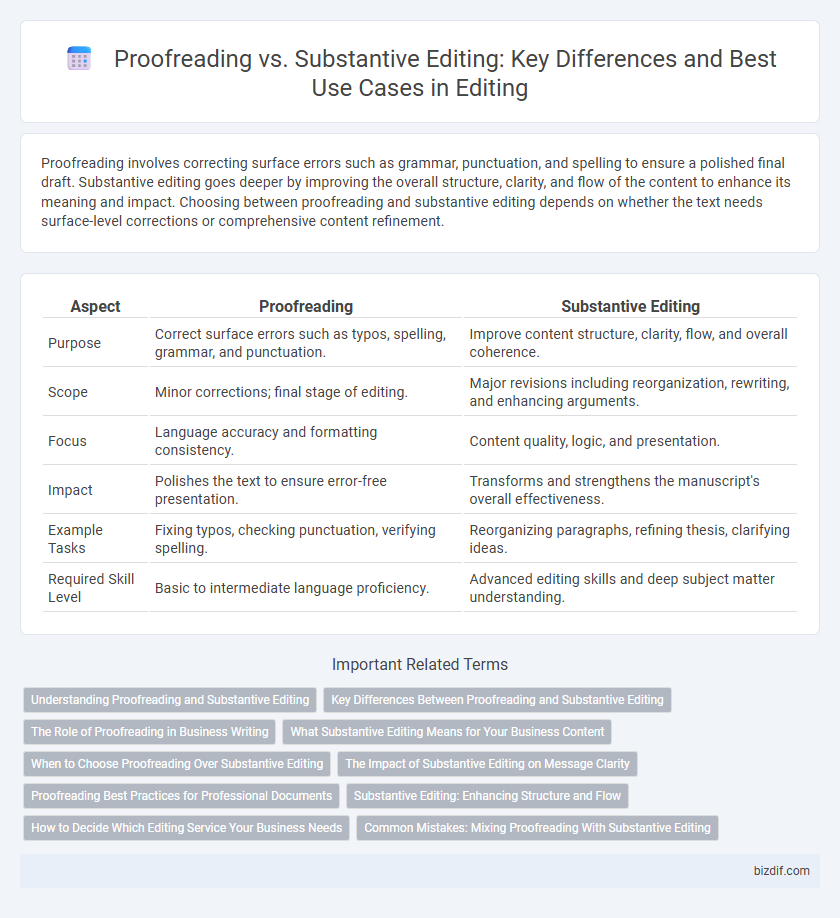Proofreading involves correcting surface errors such as grammar, punctuation, and spelling to ensure a polished final draft. Substantive editing goes deeper by improving the overall structure, clarity, and flow of the content to enhance its meaning and impact. Choosing between proofreading and substantive editing depends on whether the text needs surface-level corrections or comprehensive content refinement.
Table of Comparison
| Aspect | Proofreading | Substantive Editing |
|---|---|---|
| Purpose | Correct surface errors such as typos, spelling, grammar, and punctuation. | Improve content structure, clarity, flow, and overall coherence. |
| Scope | Minor corrections; final stage of editing. | Major revisions including reorganization, rewriting, and enhancing arguments. |
| Focus | Language accuracy and formatting consistency. | Content quality, logic, and presentation. |
| Impact | Polishes the text to ensure error-free presentation. | Transforms and strengthens the manuscript's overall effectiveness. |
| Example Tasks | Fixing typos, checking punctuation, verifying spelling. | Reorganizing paragraphs, refining thesis, clarifying ideas. |
| Required Skill Level | Basic to intermediate language proficiency. | Advanced editing skills and deep subject matter understanding. |
Understanding Proofreading and Substantive Editing
Proofreading ensures the accuracy of grammar, spelling, punctuation, and formatting by meticulously scanning the text for surface errors before final publication. Substantive editing requires a deeper analysis, focusing on content structure, clarity, coherence, and logical flow to enhance the overall quality and effectiveness of the writing. Understanding these distinct processes helps writers choose the appropriate level of editing to meet their publication standards and audience expectations.
Key Differences Between Proofreading and Substantive Editing
Proofreading primarily targets surface errors such as grammar, spelling, punctuation, and formatting inconsistencies to ensure a polished final draft. Substantive editing involves deeper structural changes, addressing clarity, flow, coherence, and content accuracy to enhance the overall quality and readability of the document. While proofreading is the final quality check, substantive editing transforms the manuscript's organization and argument strength, significantly impacting the text's effectiveness.
The Role of Proofreading in Business Writing
Proofreading in business writing ensures clarity by identifying and correcting errors in grammar, punctuation, and spelling, enhancing document professionalism. It focuses on surface-level accuracy rather than content restructuring, which distinguishes it from substantive editing. Accurate proofreading strengthens brand credibility and prevents miscommunication in corporate communications.
What Substantive Editing Means for Your Business Content
Substantive editing involves a thorough review of your business content, focusing on structure, clarity, and overall message to ensure it aligns with your brand's goals. This deep editing process enhances readability, coherence, and the impact of your communication, helping you effectively engage your target audience. Unlike proofreading, which corrects surface errors, substantive editing transforms your content to deliver strategic value and professionalism.
When to Choose Proofreading Over Substantive Editing
Choose proofreading over substantive editing when the document's content, structure, and clarity are already well-developed and only minor surface-level errors such as grammar, punctuation, and spelling need correction. Proofreading is ideal for final drafts or near-complete manuscripts that require polish rather than content overhaul. Opt for proofreading to ensure error-free presentation without altering the author's original voice or intent.
The Impact of Substantive Editing on Message Clarity
Substantive editing significantly enhances message clarity by restructuring content, refining arguments, and ensuring logical flow, which proofreading alone cannot achieve. This level of editing addresses deeper issues such as coherence, tone, and consistency, making the text more engaging and accessible for the target audience. By improving the overall structure and readability, substantive editing ensures the intended message is communicated effectively and persuasively.
Proofreading Best Practices for Professional Documents
Proofreading best practices for professional documents include meticulously checking for grammar, spelling, punctuation, and formatting errors to ensure document accuracy and consistency. Utilizing tools like style guides, digital proofreading software, and manual review enhances error detection and maintains the document's professional tone. A thorough final read-through before publication or submission solidifies clarity and credibility in polished professional writing.
Substantive Editing: Enhancing Structure and Flow
Substantive editing involves comprehensive revisions that enhance the overall structure and flow of a document, ensuring clarity and logical progression of ideas. This process addresses sentence organization, paragraph cohesion, and content consistency to improve readability and impact. Unlike proofreading, substantive editing transforms the manuscript by refining the argument development and tightening narrative flow for a polished, professional presentation.
How to Decide Which Editing Service Your Business Needs
Evaluating your manuscript's current state and desired outcome is essential in deciding between proofreading and substantive editing services. Proofreading targets surface-level corrections such as grammar, punctuation, and spelling errors, ideal for near-final drafts. Substantive editing involves comprehensive content restructuring, clarity improvement, and flow enhancement, suitable for early or mid-stage drafts requiring significant refinement.
Common Mistakes: Mixing Proofreading With Substantive Editing
Proofreading and substantive editing serve distinct purposes; proofreading focuses on correcting grammar, spelling, and punctuation errors, while substantive editing addresses structure, clarity, and content flow. A common mistake is conflating these roles, leading to overlooked deeper issues or excessive changes to minor errors. Understanding the clear boundaries enhances the efficiency and effectiveness of the editing process.
Proofreading vs Substantive editing Infographic

 bizdif.com
bizdif.com